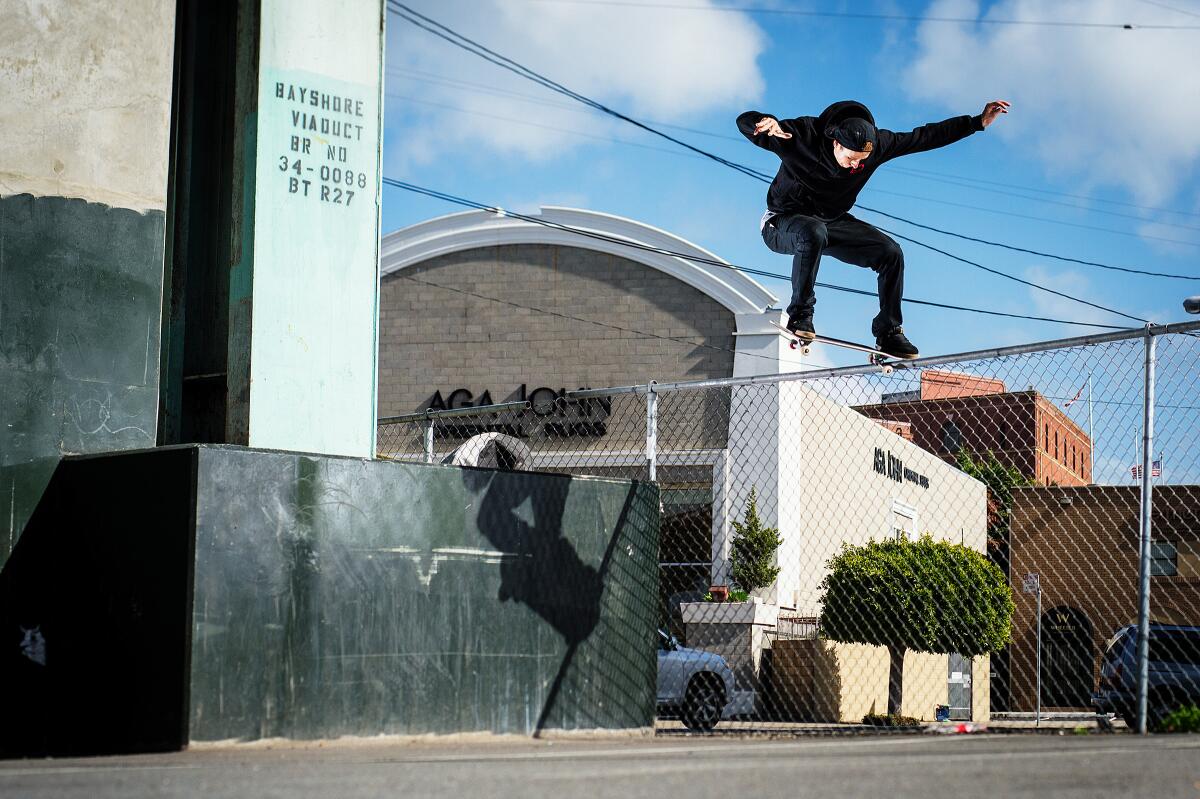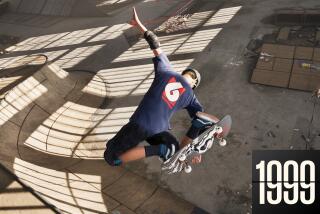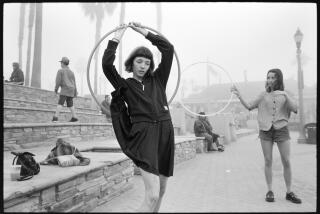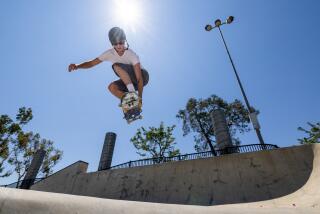A pro skater’s novel rides the triumphs and wipeouts of a precarious career
Walker Ryan got two important things when he was 14: his first skateboarding sponsor and a box of books written by his grandmother.
He can’t remember whether it was the Teenage Mutant Ninja Turtles or his friend’s older brother who got him interested in skateboarding. Forgive his fuzzy memory: He was 7. At age 10, Ryan started sending what skaters call “sponsor-me tapes”; four years later, he got his first sponsor, the sporting goods chain Play It Again Sports. Skateboarders earn their living from sponsorships, and they start young.
It was Ryan’s grandmother, novelist Susan Trott, who bequeathed him his literary sensibility. Trott’s oeuvre, contained in that box, was “very adult,” he recalls. “Real romance elements. There’s suspense and really a lot of sex and just real-life stuff in it.” Young Walker had no idea what his Grummy (as she is called) had been up to. “It was mind-blowing to me. Like, whoa, she can write the kinds of things I’ve only seen in R-rated movies.”

Nearly 20 years later, Ryan’s two passions have come together in his first novel, “Top of Mason,” which he has self-published through his online shop, Old Friends. There’s suspense and sex and other “real-life stuff” in there, but also the very un-Grummy-ish milieu of San Francisco’s skateboarding scene. Henry Philip, the protagonist, is 29, working as a cleaner at the SRO hotel where he also lives, wounded from the breakup of a long-term relationship. His career in skateboarding seemingly behind him, Henry drifts through his days running shady errands for his boss at the hotel, skating at a local skatepark and pining for his ex.
Ryan, who grew up in the small Napa Valley city of St. Helena, became a professional skateboarder in 2011, when he was 23. “Top of Mason” not only features some nuanced descriptions of the ride (popping a board back into your hands feels like “going from Batman back to Bruce”) but it also anatomizes changes in the industry — notably in the contrast between a young celebrity and an eccentric former skater gone to seed.
Nathan Apodaca, known on TikTok as @420doggface208, went viral for a video of him skateboarding to Fleetwood Mac’s ‘Dreams.’ Meet the man behind the viral clip.
Devon West, a.k.a. Dizzy Dev, is a world-famous skater and rap star who rolls with an entourage and management team and lives in a four-story mansion. A tiny percentage of pros reach this level of success. Most professional skaters make hardly any money at all. Too many end up like Gary, an old friend of Henry’s who now lives on the street, scamming clothing stores, correcting people’s grammar and smoking crack. As Henry navigates his post-skateboarding, post-relationship existence, he oscillates between these two figures — the dream and the nightmare.
Ryan, who grew up “going on crazy hill bombing missions” in the Bay Area, is intimately familiar with the setting of his story. “Skateboarding in San Francisco has always been gnarly,” he says. “It’s always been a destination. It was definitely the Mecca for skaters who wanted to turn pro and get noticed at a certain time, like the early mid-’90s. And then, when I was in high school, I feel like it had moved to Southern California.”
Now, the action is largely focused not in any geographical spot but on Instagram, where careers can be born, reputations bolstered and a lot of money made. In more analog days, when Ryan (and his hero Henry) were coming up, the cultural market was dominated instead by full-length skate videos, usually produced by a company, artfully weaving together solo “video parts” from a team of sponsored skaters. The release of a major video (sometimes directed by known filmmakers like Spike Jonze) would be an event.
Along came YouTube and Thrasher Magazine’s increasingly dominant web presence, which allowed skaters to rapidly shoot and disseminate their own videos — video parts focusing on a single skater as opposed to an entire team. Now, even full-length company videos are released a part at a time, driving the market toward individual superstars. Instagram slices and dices even more, driving clicks toward single tricks.
In “Top of Mason,” Instagram is practically its own character. After experiencing a comeback via the platform, Henry gets sucked into its validating immediacy and its reductive star machinery. For the author, it was an opportunity to showcase an important generational shift. “You can build more hype for yourself organically through Instagram nowadays than any media organization or brand can do for you,” he says. “That’s how you build your name now in skateboarding.”
What hasn’t changed is the fundamental fact that skateboarding is a capricious hustle economy, with much of the marketing responsibility placed on the skaters, who are effectively low-paid contractors. Enabled by technology and freed from team videos, the skaters who are savviest on social media now tend to be the most successful, but what is that really measuring? Artful skateboarding or great salesmanship?
“We put pro skaters on such a high pedestal,” Ryan says, “but there’s hundreds, if not thousands of other guys who are just as good, who never went pro, but basically spent their youth or their 20s focused on this one career path.” And if they don’t succeed as skaters, they’re often left with little direction or other skills. Gary, “Top of Mason’s” retired vagrant, is the kind of figure skateboarding often unceremoniously discards. In Gary’s case, addiction, mental illness and a tragic accident lead to a life of homelessness and petty crime.
Jeff Grosso, a skateboarder from Arcadia who rose to the greatness in the 1980s before falling to the depths of despair and making a comeback, died Tuesday at 51.
“I have so many friends that that’s happened to,” Ryan says. “But really, there’s no rhyme or reason to it. It’s basically random who gets to turn pro, and it’s also subjective and kind of silly and, I think, kind of at its core pretty meaningless.”
Henry confronts these realities in his post-breakup funk. Depressed and adrift, he bumps into Gary, whose wild antics and anarchic lifestyle appeal to him in the moment. After a whirlwind bender, Henry encounters Dizzy Dev and his entourage, who plug him back into a skate world he doesn’t recognize.
“Top of Mason” takes place over two months, during which Henry tries to determine what the rest of his life will look like.
Ryan himself managed to thrive in skateboarding. He rode for companies like Organika and DVS Shoes and now skates for Sovrn. He’s put out numerous video parts, traveled the world, participated in contests and even consulted for and appeared in the 2006 film “Little Children.” Recently, he founded his own brand, Old Friends, which he hopes to expand over the next few years, because at 32, he’s nearing the end of his professional career.
But pro skaters don’t really retire; they just get other jobs. In addition to his shop, of course, there’s fiction. But writing is just as fickle and financially precarious as skateboarding. The things we love can’t always sustain us, but that’s no reason to stop. “I’m too stubborn to not want to keep skating,” says Ryan. “Because it’s something I love, you know?”
“Hollywood Park,” a new memoir from the frontman for the Airborne Toxic Event, recounts his childhood in L.A.’s Synanon cult — and his recovery.
Clark is the author of “An Oasis of Horror in a Desert of Boredom” and the forthcoming “Skateboard.”
More to Read
Sign up for our Book Club newsletter
Get the latest news, events and more from the Los Angeles Times Book Club, and help us get L.A. reading and talking.
You may occasionally receive promotional content from the Los Angeles Times.






